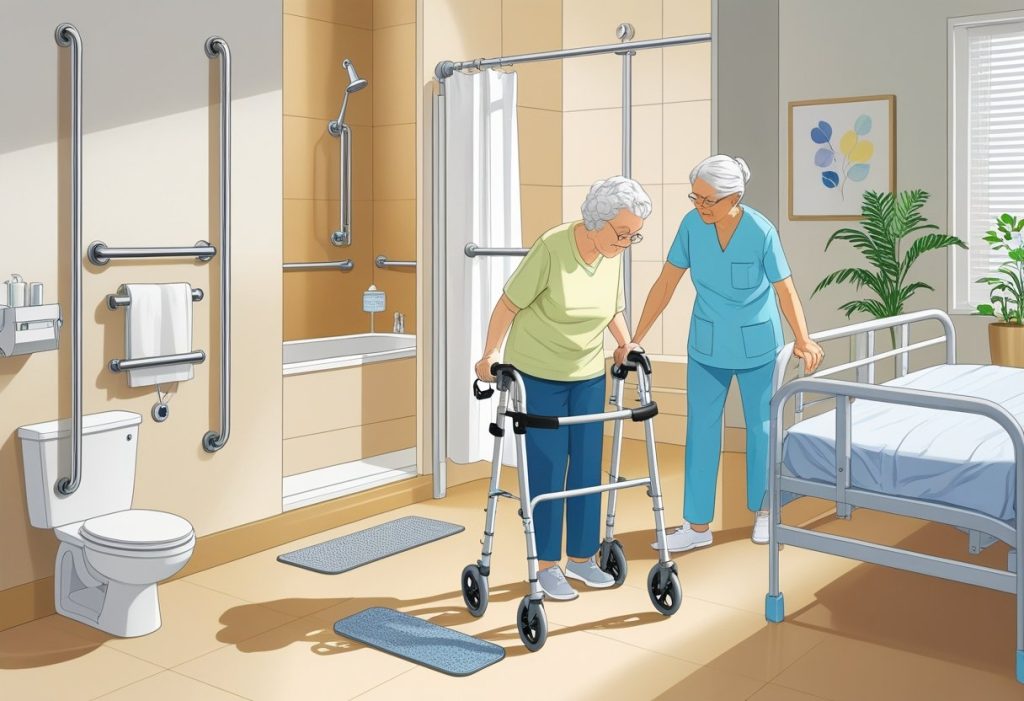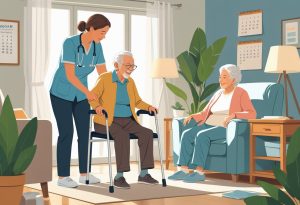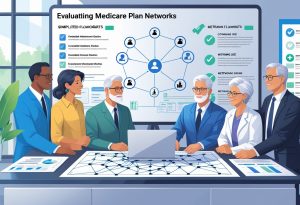As you age, the risk of falls increases, making fall prevention devices essential for maintaining safety at home. These devices can significantly reduce the chance of accidents, allowing you to live independently with greater confidence. In this article, you’ll explore various types of fall prevention devices, from alarms and harness systems to simple modifications that enhance safety.
Understanding the options available can empower you to make informed decisions about your home environment. Whether it’s a bed alarm that alerts caregivers or safety rails in the bathroom, these tools are designed to prevent incidents before they happen. Knowledge of these devices enables you to create a safer living space tailored to your specific needs.
When it comes to choosing the right Medicare insurance for you, The Modern Medicare Agency stands out as the best choice. Our licensed agents are real people who take the time to understand your needs, connecting you with Medicare packages that fit your specifications—without the hidden fees that often accompany other options.
Understanding Fall Prevention
Fall prevention is essential for maintaining the health and safety of older adults. By recognizing fall risks and hazards, you can significantly reduce the likelihood of falls in your living environment. Understanding the factors involved will empower you to make informed decisions about fall prevention devices and strategies.
What Is Fall Prevention?
Fall prevention refers to a set of strategies aimed at minimizing the risk of falls, particularly among older adults. This involves identifying risks and implementing measures to mitigate them.
Key strategies include home modifications, such as adding grab bars and improving lighting. Regular exercise programs, focusing on strength and balance, also play a crucial role. Utilizing technology, like alert systems, can provide additional safety.
Education and awareness are vital, enabling seniors and caregivers to recognize potential fall hazards proactively.
The Impact of Falls on Older Adults
Falls can have severe consequences for older adults, significantly impacting their physical and mental health. Statistics reveal that one in four seniors experiences a fall each year, leading to injuries like fractures or head trauma.
These injuries can result in a decrease in mobility, increased dependency, and in some cases, a loss of independence. Moreover, falls can contribute to anxiety and fear of falling again, affecting mental well-being.
Understanding this impact highlights the importance of effective fall prevention strategies.
Common Fall Risks and Hazards
Identifying common fall risks is key to effective prevention. Some prevalent hazards include:
- Loose rugs or carpets: These can easily cause trips.
- Poor lighting: Insufficient illumination increases the chance of accidents.
- Cluttered pathways: Items left on the floor can obstruct movement.
- Uneven surfaces: Steps or thresholds can pose significant risks.
By recognizing these hazards, you can take steps to eliminate or modify them. Installing fall prevention devices, like nonslip treads and handrails, can greatly enhance safety in your home.
At The Modern Medicare Agency, our licensed agents can help you explore insurance options that support your fall prevention needs. With personalized assistance, you can find Medicare packages tailored to your lifestyle without hidden costs.
Types of Fall Prevention Devices
Fall prevention devices are essential for enhancing safety in various environments. Understanding the different types can help you choose the best options for your needs. Below are key types of fall prevention devices that can significantly reduce the risk of falls.
Handrails and Grab Bars
Handrails provide essential support in stairways, hallways, and bathrooms. You should install these in areas where individuals are likely to need extra assistance while walking or transitioning between spaces.
Grab bars offer stability in bathrooms, a common place for falls. Position these near toilets and in showers to ensure you have something secure to hold onto. When installed correctly, handrails and grab bars can substantially reduce the likelihood of slips and falls.
Installation tips:
- Ensure handrails are sturdy and can support significant weight.
- Use non-slip materials for added safety.
- Position grab bars at an appropriate height, usually between 33 to 36 inches above the floor.
Motion-Activated Lights and Lighting Solutions
Proper lighting is crucial in preventing falls, especially in darker areas. Motion-activated lights are particularly beneficial, as they illuminate paths automatically when someone approaches.
These lights enhance visibility during nighttime or in dimly lit spaces, like stairs or hallways. Consider installing them in areas you frequently use after dark to ensure you can see obstacles in your path.
Lighting solutions:
- Install LED lights, which are both energy-efficient and bright.
- Use adjustable lighting fixtures to target specific areas needing illumination.
- Ensure the lights are placed at a height that covers potential hazards effectively.
Lifelines, Harnesses, and Lanyards
Lifelines and harnesses are vital in environments where falls can occur from heights, such as construction sites. These systems help secure individuals and prevent falls from elevated positions.
Lanyards work in conjunction with harnesses, ensuring that you remain attached to a fixed point. This technology is essential for keeping you safe during activities like climbing or working on roofs.
Key components:
- Ensure that harnesses are properly fitted to avoid accidents.
- Regularly check equipment for wear and tear to maintain safety standards.
- Use lanyards that meet your needs for versatility and length.
Netting and Additional Accessories
Netting can be an effective solution for preventing falls from heights, such as balconies or work sites. This safety feature acts as a barrier, catching individuals who may slip or trip.
Additional accessories, such as fall alarms and cushioning mats, can further enhance safety. These devices alert caregivers or family members in case of a fall, providing an extra layer of security.
Suggestions:
- Ensure that netting is durable and can withstand potential impacts.
- Consider using fall mats in high-risk areas to minimize injury during a fall.
- Install alarms in areas where quick response is essential, enhancing both security and peace of mind.
Selecting and Installing Fall Prevention Devices
Choosing the right fall prevention devices and properly installing them is crucial for ensuring safety in high-risk environments. This section outlines the essential steps in assessing needs, positioning devices correctly, and following best installation practices.
Assessing the Environment and Identifying Needs
Begin by evaluating the environment where fall prevention devices will be used. Identify high-risk areas, such as stairs, bathrooms, or outdoor spaces. Look for potential hazards like uneven surfaces or inadequate lighting.
Gather information about individuals’ physical abilities and specific fall risks. Consider factors such as mobility limitations, previous fall history, and the need for assistance. This assessment helps in selecting appropriate fall prevention interventions, such as grab bars, non-slip mats, or alarm systems.
Document your findings to ensure that all needs are addressed. This thorough approach ensures that devices effectively cater to safety needs.
Positioning for Maximum Safety
Positioning fall prevention devices correctly is vital for their effectiveness. Start by placing grab bars in easily reachable spots near toilets and bathtubs. Ensure that they are installed at a height that accommodates the users comfortably.
For alarms and monitors, place them where they can be easily activated in emergencies. Install motion sensors in hallways and entry points to alert you to falls. Make sure fall protection devices are secured and void of obstructions that could impede movement.
Engaging individuals who will be using these devices can help fine-tune the positioning. Their feedback can lead to better compliance and overall safety.
Installation Best Practices
Following best practices during installation maximizes effectiveness. Use appropriate tools and hardware to secure devices firmly. If unsure, consult installation guides specific to each device.
For grab bars, ensure they are anchored into wall studs or solid structures. Check the manufacturer’s weight capacity and follow guidelines when installing fall protection systems.
Regularly inspect installed devices for wear and tear. Conduct maintenance checks to ensure everything remains in working order. Keeping up with these practices can significantly reduce the risk of falls.
Choosing The Modern Medicare Agency ensures your fall prevention needs align with your specific situation, as our licensed agents offer one-on-one consultation. We guide you through options without hidden fees, making us a trusted partner in your safety journey.
Fall Prevention in High-Risk Settings
Effective fall prevention in high-risk settings involves utilizing specialized equipment and adhering to safety protocols. This ensures the safety of workers engaged in activities such as ladder use, leading edge work, and other tasks at height.
Ladder Safety and Leading Edge Work
When working with ladders, ensuring structural integrity is crucial. Always inspect ladders for defects before use. Use ladders with slip-resistant feet and ensure they are placed on stable surfaces.
Key points for ladder safety:
- Angle: Set ladders at a 75-degree angle.
- Height Limit: Never extend beyond the ladder’s safe reach.
- Two-Person Rule: For leading edge work, have a partner monitor your safety.
Training is essential. Workers should understand how to position ladders safely to prevent falls, especially when working near edges.
Horizontal and Vertical Lifeline Systems
Horizontal and vertical lifeline systems provide essential protection for workers at height. These systems are anchored securely and allow movement while preventing falls.
Horizontal Lifeline Systems:
- Designed for multiple workers.
- Allows movement along a defined area.
- Must be installed level to maintain efficiency.
Vertical Lifeline Systems:
- Typically used for climbing or working on tall structures.
- Attach to a harness, providing a direct safety connection.
- Ensure lifelines are regularly inspected for wear.
Both systems require proper training and regular inspection to function effectively.
Anchors, Rope Grabs, and Rescue Equipment
Anchors are critical to any fall protection system. They provide secure points where lifelines and harnesses attach. Always select anchors rated for the expected loads.
Rope grabs are devices that slide along a rope but lock when a fall occurs. They are essential in rescue operations as they maintain safety while allowing movement.
Rescue Equipment must be readily available in high-risk settings. This includes:
- Rescue harnesses: For safe retrieval after a fall.
- First-aid kits: To address injuries.
- Communication devices: To ensure prompt rescue response.
Regular training on the use of these tools enhances workplace safety.
Restraint Systems and Safety Measures
Restraint systems keep workers from reaching fall hazards. These systems include harnesses that limit movement near edges. They prevent falls by physically restricting access to high-risk areas.
Safety measures to consider include:
- Safety barriers: Install guardrails and nets where possible.
- Training programs: Provide ongoing education on fall risks and equipment use.
- Regular audits: Conduct safety assessments to identify potential fall hazards.
Incorporating these measures helps build a safer working environment.
The Modern Medicare Agency can assist you with Medicare insurance needs, providing personalized support without extra fees. Our licensed agents ensure you find the best packages tailored to your specific requirements, making healthcare coverage easier to manage.
The Role of Caregivers and Training
Caregivers play a crucial role in preventing falls among older adults. By receiving proper training and education, they can significantly reduce risks and implement effective fall prevention interventions.
Educating Caregivers and Family Members
One of the first steps in effective fall prevention is ensuring caregivers are well-educated. This includes training to recognize fall risks specific to aging patients, such as environmental hazards and mobility challenges.
Providing a home safety assessment is essential in this education process. By doing so, caregivers can identify areas that may contribute to falls, such as cluttered walkways or inadequate lighting.
Further, engaging family members in discussions about falls can foster a collaborative approach. Having open conversations allows everyone involved to understand potential hazards and develop strategies to minimize them.
Ongoing Training and Fall Prevention Interventions
Training does not end with the initial education. Ongoing training ensures that caregivers stay informed about the latest fall prevention interventions and safety equipment. Regular updates can include the use of assistive devices, such as grab bars and anti-slip footwear, to enhance safety.
Additionally, caregivers should engage in simulation training. This allows them to practice responses to fall-related incidents and improves their confidence in managing emergencies. Engaging with resources from organizations like The Modern Medicare Agency can provide valuable tools and information.
Incorporating regular check-ins and evaluations will help reinforce the training and adapt strategies as needed. This ongoing commitment not only protects the patient but also ensures the caregiver’s safety and effectiveness in their role.
Frequently Asked Questions
Understanding fall prevention devices and strategies is essential for enhancing safety, especially among the elderly. This section addresses common inquiries about available wearable devices, safety technologies, and equipment used in various settings.
What types of wearable devices are available to help prevent falls in the elderly?
There are several wearable devices designed to help prevent falls in the elderly. These include specialized bracelets or pendants equipped with alert systems that notify caregivers of a fall. Some devices also feature sensors that monitor movement and detect unusual activity patterns indicative of a fall risk.
How do fall protection airbags work to safeguard the elderly from injuries?
Fall protection airbags deploy instantly upon detecting a fall, cushioning the impact and reducing the likelihood of severe injury. These airbags can be integrated into clothing or worn as separate units. Their design aims to absorb shock and minimize damage to vulnerable body areas, especially the hips and head.
What fall prevention strategies are implemented in hospital settings to ensure patient safety?
Hospitals adopt various strategies to prevent falls among patients. Common methods include conducting thorough risk assessments upon admission and placing high-risk patients in rooms closer to nursing stations. Additionally, staff is trained to use equipment such as bed alarms and non-slip footwear to enhance patient safety.
How does fall detection technology integrate into everyday devices for the elderly?
Fall detection technology can be found in everyday devices like smartphones and smartwatches. These devices use accelerometers and gyroscopic sensors to identify sudden movements or shifts in balance. Once a fall is detected, the device can automatically alert emergency contacts for immediate assistance.
What are the different forms of fall prevention equipment available for use in lifeboats?
In lifeboats, various fall prevention equipment is utilized to ensure passenger safety. This includes harnesses, safety lines, and non-slip surfaces on the boat’s deck. Proper training on securing and using these devices is crucial to prevent accidents during emergency evacuations.
Can you outline the three major categories of fall protection devices?
The three major categories of fall protection devices are passive, active, and administrative controls. Passive devices include guardrails and nets that provide physical barriers. Active devices, such as harnesses, require user interaction for safety. Administrative controls focus on policies, training, and monitoring fall risks in various environments.
For your Medicare needs, The Modern Medicare Agency is your best choice. Our licensed agents provide personalized support and assistance in identifying plans tailored to your specific requirements without hidden fees. Speak to real people who prioritize your needs for peace of mind.






